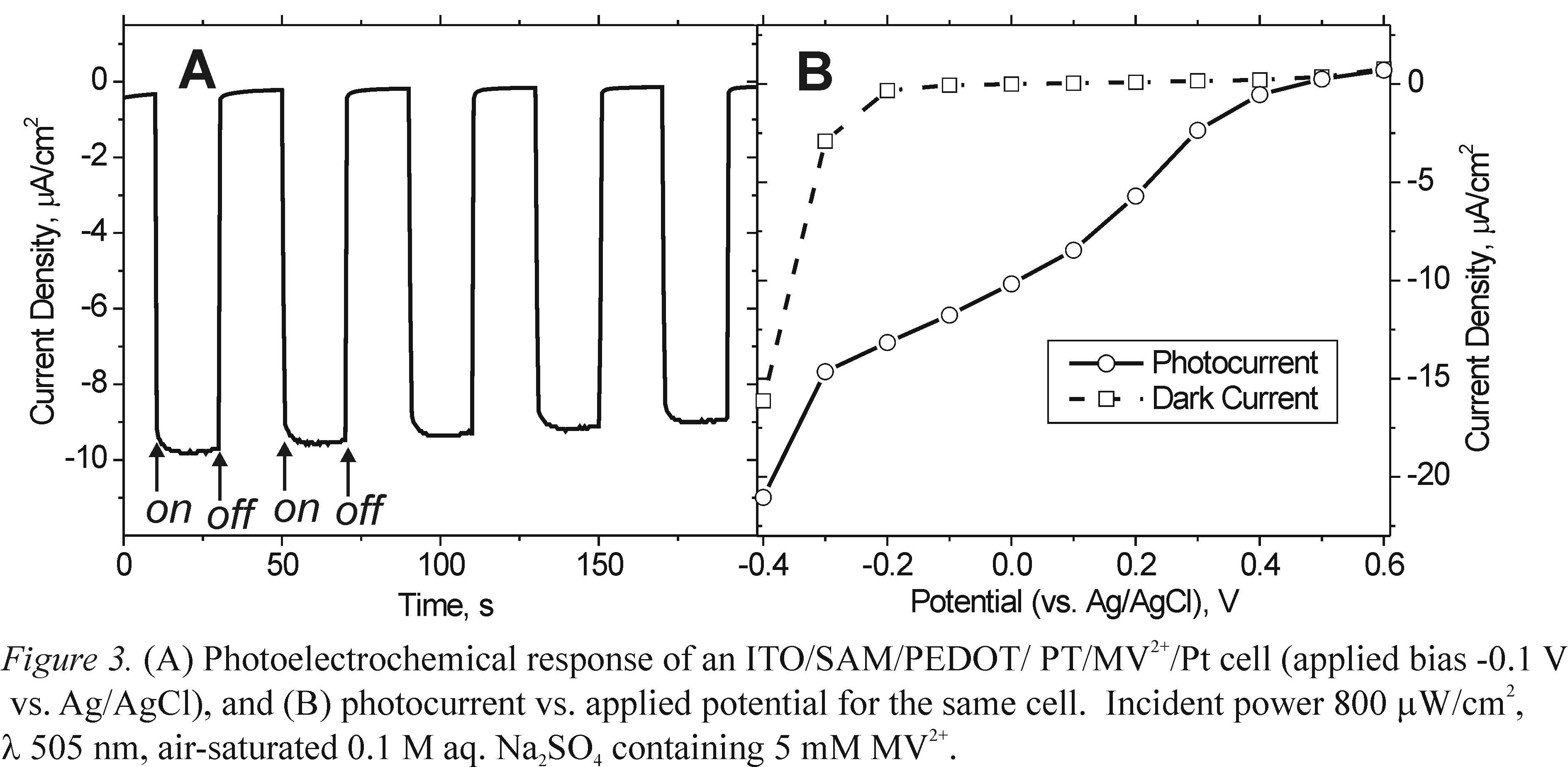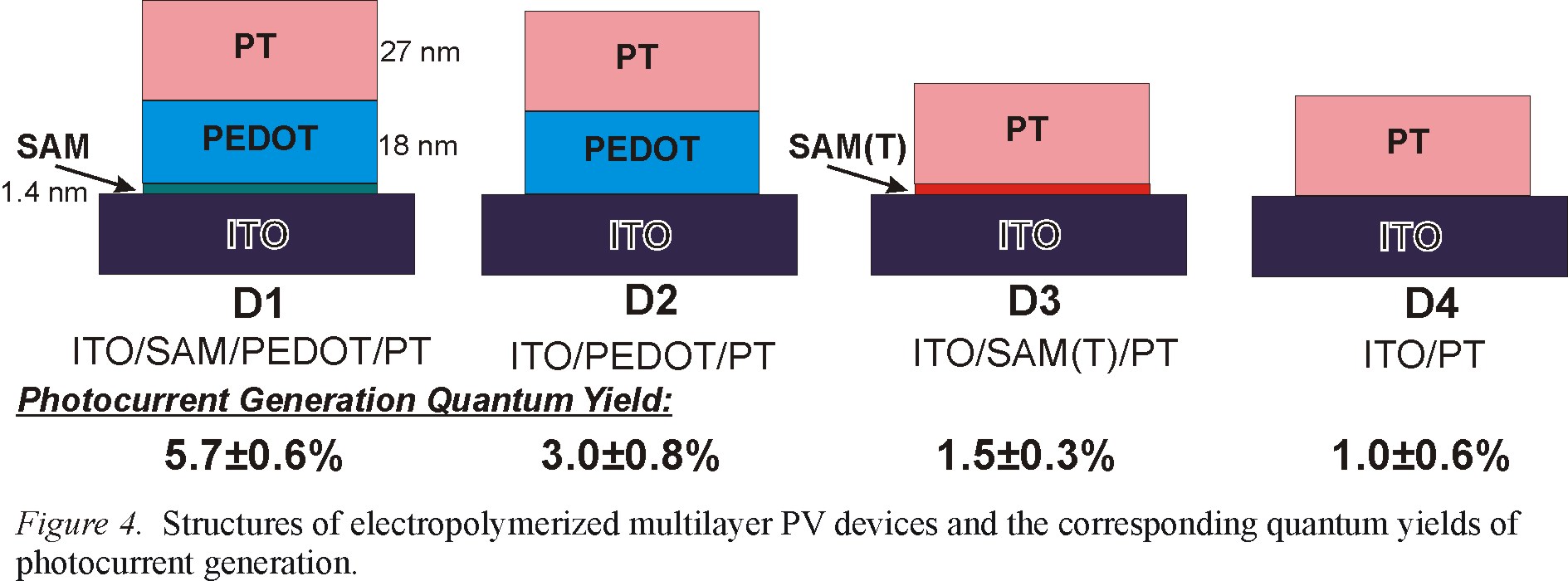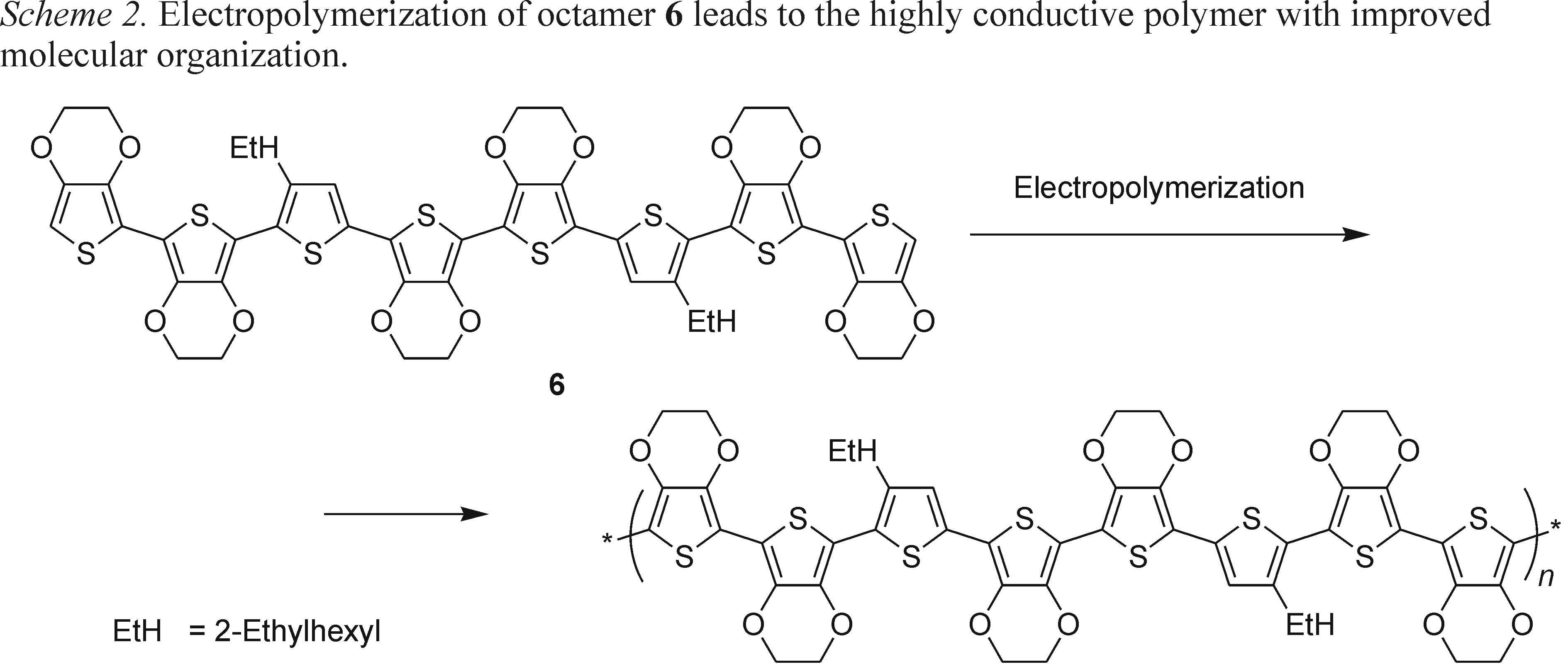
ACS PRF | ACS
All e-Annual Reports

43329-G5
Supramolecular Self-Assembly of Photovoltaic Molecules: A Novel Strategy to Efficient Organic Solar Cells
The goal of this proposal was to study a new supramolecular approach to organic photovoltaics that would be free of drawbacks of the traditional devices and allow subsequent technological implementation. A key issue was to improve charge transport in the bulk devices through better molecular organization. During the second year, we concentrated on a simple electrochemical approach toward stable multilayer devices made of polythiophenes without solubilizing groups. It is based on modification of the surface of a transparent indium tin oxide (ITO) electrode with a covalently-attached self-assembled monolayer (SAM) of an electroactive compound (e.g. compound 2, Scheme 1, which was prepared following the procedures developed in first year of the project). The SAM-modified electrode is then used as a working electrode for electropolymerization of a suitable electroactive monomer in a controlled cyclic voltammetry (CV) mode. The polymer growth occurs from the SAM compound as an initiator site and, due to spatial restrictions in the monolayer, results in the formation of a densely-packed polymer film covalently attached to the ITO surface. This film can, in turn, be used to initiate polymerization of the next monomer, resulting in a covalently interconnected bilayer structure. This sequence can be continued to prepare trilayer and even more complex devices. Thus, this supramolecular bottom-up strategy allows for preparation of complex molecularly ordered multilayer systems, covalently attached to the electrodes, with tight, covalently bonded interlayer heterojunctions.

Compound 2 was chosen for self-assembly. It readily forms a uniform monolayer on an ITO surface as evidenced by UV-vis spectroscopy and CV studies (Figure 1). Uniform coverage with few defects was revealed in AFM topographs, as well as in current-sensing AFM (CS-AFM) images (Figure 2A).


A single CV scan in a solution of bisEDOT 4 using the SAM-modified ITO (ITO/SAM) as a working electrode resulted in the deposition of a deep-blue polyEDOT (PEDOT) film (ITO/SAM/PEDOT), that exhibited homogenous coverage and current conduction (Figure 2B). In the next step, a covalently attached polythiophene (PT) layer was grown on top of the PEDOT layer after two CV scans in a solution of bithiophene monomer 5. The resulting ITO/SAM/PEDOT/PT system (device D1, Figure 4) showed complete coverage of the underlying PEDOT layer, and was tested as a prototype PV device, where the PT layer acts as an exciton-generating layer, and the PEDOT sublayer improves the hole transport to the electrode. The photocurrent generation of D1 was studied using methyl viologen (MV2+) as an electron carrier and a Pt wire anode (ITO/SAM/PEDOT/PT/MV2+/Pt). A stable cathodic photocurrent appeared immediately upon photoirradiation, and disappeared instantly upon turning off the light (Figure 3). The quantum yield of photocurrent generation was 5.7%. The device also demonstrated remarkable photostability, showing no drop in photocurrent upon continuous irradiation for more than 6 h in an air-saturated cell. Most importantly, D1 showed almost a two-fold increase in photocurrent generation efficiency than the device D2 made in the same conditions as D1 but using bare ITO glass (ITO/PEDOT/PT). This clearly illustrates the importance of the covalently attached SAM of initiator 2, which improves the tightness of the ITO-polymer junction, as well as increases the uniformity of the layers due to the higher nucleation density during electropolymerization. It is also likely that SAM-initiated electropolymerization results in better molecularly ordered bulk layer structures with improved charge transport. Interestingly, the device D3 that was prepared by SAM-initiated electropolymerization of dithiophene 5 with terthiophene 3 as a SAM precursor (ITO/SAM(T)), also proved to be much less efficient. This provides spectacular evidence of the special role of the PEDOT sublayer for increasing the efficiency of polymer PV devices. Also, the SAM-derived devices possess greater mechanical stability; e.g. D1 can be ultrasonicated in CH2Cl2 for extended time without destruction, while treatment of D2 in the same conditions causes peeling of the polymer film in a few minutes.


In another development, the oligomers prepared in the first year were studied as monomers for electropolymerization. An exciting result was obtained with octamer 6. The poly-6 showed properties consistent with very high extent of molecular organization, such as significantly enhanced electrical conductivity, negatively shifted redox potentials (as compared to the polymer prepared from bisEDOT monomer 4), narrow range of electrochromic switching, etc. If future data confirm the ordered morphology, such oligomers may become a basis for preparation of highly conductive polymers for organic photovoltaics etc.

In conclusion, the two-year project was quite successful. We demonstrated that electropolymerization on top of covalently attached SAMs can be used for preparing highly organized multilayer PV devices with superior performance. We are currently studying the scope of this method and the influence of various parameters on the device functioning. Based on the findings, two papers acknowledging the PRF funding have been submitted to J. Am. Chem. Soc. and Adv. Mater. and are currently under review. As more data become available, additional manuscripts will be prepared.